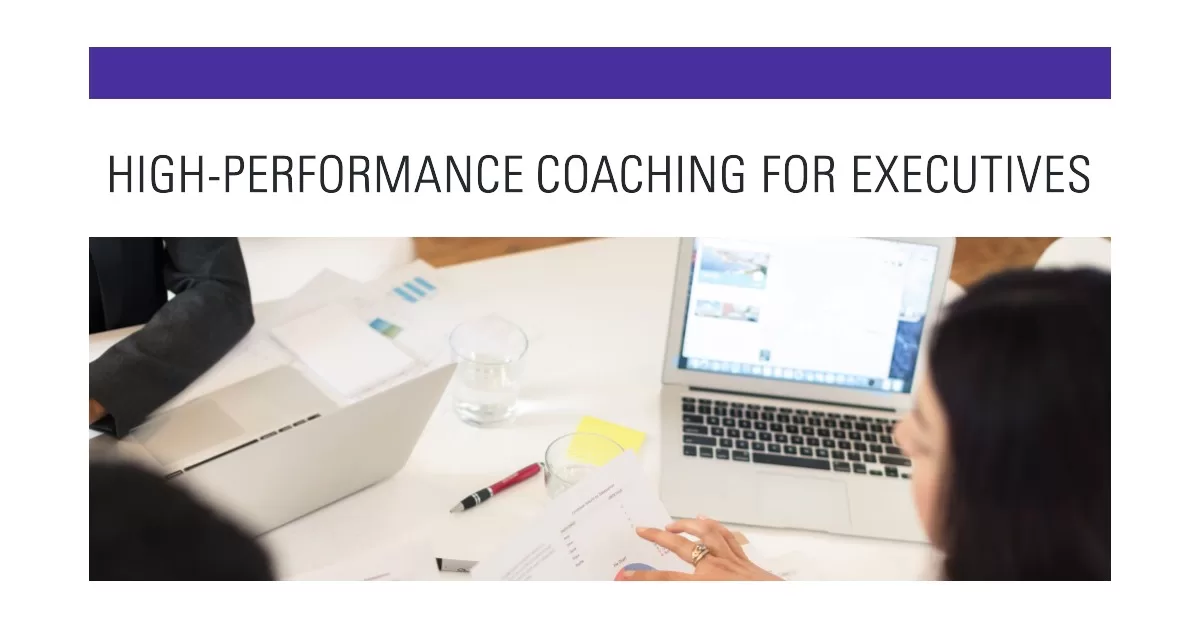High-performance coaching for executives is a specialized form of coaching that focuses on enhancing the performance of top-level professionals in their respective fields. This type of coaching is designed to help executives identify their personal and professional goals, create actionable plans to achieve those goals and develop skills that will enable them to lead effectively while increasing productivity.
High-performance coaching for executives is becoming increasingly popular in today’s fast-paced business environment where leaders are expected to deliver results quickly. The benefits of this kind of coaching include increased self-awareness, improved decision-making abilities, enhanced communication skills, better time management, and greater overall effectiveness as a leader. Through high-performance coaching, executives can overcome personal and professional challenges, learn how to manage stress effectively, and measure progress toward achieving their goals. Ultimately, high-performance coaching can help executives continually develop and improve themselves by providing a structured approach to learning and growth.
Table of Contents
Key Takeaways
- High-performance coaching enhances the performance of top-level professionals by helping them identify personal and professional goals, developing skills for effective leadership, and increasing productivity.
- Techniques used in high-performance coaching include goal setting, feedback, accountability, and skill-building exercises, as well as identifying personal values and aspirations and setting SMART goals.
- Effective change management is critical in navigating organizational politics and overcoming personal and professional challenges, managing stress, and measuring progress.
- Continual development and improvement are important for maintaining momentum and achieving goals, and high-performance coaching helps executives become more effective leaders.
What is High-Performance Coaching?
High-performance coaching is a process that aims to enhance the effectiveness of executives by developing their skills, attitudes, and behaviors in a way that maximizes their potential for success. This type of coaching is designed to help executives achieve peak performance in their roles by addressing specific areas of improvement. High-performance coaching can include various techniques such as goal setting, feedback, accountability, and skill-building exercises.
The primary objective of high-performance coaching is to help executives develop the skills they need to succeed in their roles. This may involve identifying areas where an executive needs improvement and designing a plan to address those issues. The coach will work with the executive to create achievable goals that are aligned with the organization’s overall objectives. The coach will also provide regular feedback on progress, which helps keep the executive motivated and focused on achieving their goals.
An essential aspect of high-performance coaching is accountability. The coach will hold the executive accountable for meeting their commitments and taking action toward achieving their goals. This creates a sense of responsibility within the executive and ensures that they remain committed to making meaningful changes in how they approach their work.
High-performance coaching is a process designed to help executives improve their capabilities and reach peak performance in their roles. It involves identifying areas for improvement, setting achievable goals aligned with organizational objectives, providing regular feedback on progress, and holding executives accountable for taking action toward achieving those goals. Ultimately, this type of coaching helps organizations create more effective leaders who can drive growth and innovation while maximizing results.
Identifying Your Goals

When identifying goals, it is important to take into account one’s personal values and aspirations. This step is essential in high-performance coaching for executives because it enables them to align their objectives with what they truly want to achieve in life. Identifying goals that resonate with an individual’s core beliefs and motivations provides a sense of purpose and direction, which can help boost motivation and performance.
Once personal values are established, the next step is to set specific, measurable, achievable, relevant, and time-bound (SMART) goals. Having clear objectives increases accountability and makes it easier to track progress toward achieving these targets. When setting SMART goals in high-performance coaching for executives, coaches often encourage clients to aim higher than they think possible while keeping their expectations realistic.
To ensure that identified goals remain on track throughout the coaching process, it is essential to monitor progress regularly. Regular check-ins provide opportunities for feedback and adjustments as needed. In high-performance coaching for executives, progress tracking also helps identify any potential barriers or challenges that may arise along the way so that appropriate strategies can be developed beforehand.
Identifying personal values and aspirations when setting goals is crucial in high-performance coaching for executives. It allows individuals to align their objectives with what they truly want to achieve in life while providing a sense of purpose and direction. Setting SMART goals ensures clarity of targets while regular monitoring helps maintain focus on achieving those objectives over time.
Creating an Action Plan
This section will focus on creating an action plan, which involves two key components: defining strategies and tactics, and prioritizing tasks. Defining strategies involves identifying the overall approach or direction that will be taken to achieve the desired outcome, while tactics involve specific actions that will be taken to implement those strategies. Prioritizing tasks is crucial to ensure that time and resources are allocated efficiently toward achieving the most important goals first. By following these steps, executives can create a clear roadmap for achieving their goals in a structured and efficient manner.
Defining Strategies and Tactics
Defining strategies and tactics for executives is a critical component of effective leadership that requires careful planning and execution to achieve desired outcomes. Strategies are long-term plans that outline the overarching goals and objectives of an organization, while tactics are the specific actions taken to achieve those goals. By defining clear strategies and tactics, executives can better align their teams toward achieving common goals, which can lead to increased productivity, profitability, and overall success.
To define effective strategies and tactics, executives must first have a deep understanding of their organization’s strengths, weaknesses, opportunities, and threats. This requires a comprehensive analysis of internal processes as well as external market conditions. Executives must then use this information to develop strategic plans that focus on key areas such as product development or customer acquisition. Once these strategies have been defined, tactical plans should be developed to support the achievement of each goal outlined in the strategy. These tactical plans should include specific action items with timelines and metrics for measuring progress toward achieving each goal.
Prioritizing Tasks
Prioritizing tasks is a crucial aspect of effective leadership that involves identifying and ranking the most important activities to achieve organizational goals. It requires an executive’s ability to focus on key deliverables, delegate responsibilities, and manage time wisely. A high-performance coach can help executives develop this skill by guiding them through the following prioritization techniques:
- Identifying high-value projects and initiatives
- Prioritizing tasks based on urgency and importance
- Breaking down large projects into smaller, manageable tasks
- Delegating responsibilities effectively
- Developing efficient time-management strategies
These techniques ensure that executives are able to allocate resources effectively, optimize productivity, and achieve desired outcomes efficiently. By prioritizing tasks effectively, executives can also reduce stress levels while maintaining focus on strategic objectives.
Prioritizing tasks is a critical skill for any executive looking to maximize their potential in today’s fast-paced business environment. High-performance coaching provides executives with the tools they need to excel in this area by focusing on key aspects such as effective delegation of responsibilities and developing efficient time-management strategies. By implementing these techniques consistently over time, executives can ultimately improve their performance while achieving greater success in their careers.
Developing Leadership Skills
Enhancing one’s leadership skills requires a comprehensive understanding of the various approaches to leadership and their potential impact on organizational performance. Leadership is not just about giving orders and delegating tasks, but it involves effectively managing people, resources, and processes to achieve common goals. Therefore, high-performance coaching for executives should include developing leadership skills that are relevant to the current business environment.
One approach to leadership is the transformational style where leaders inspire and motivate their team members to perform beyond their expectations. Transformational leaders communicate a vision of success that aligns with the organization’s goals, values, and beliefs. They also empower their followers by providing them with autonomy, support, and recognition for their achievements. This approach can enhance employee engagement, job satisfaction, productivity, and innovation.
Another approach is the situational style where leaders adjust their behavior based on the situation at hand. Situational leaders assess the readiness level of their followers in terms of task ability and motivation before deciding on an appropriate leadership style. For instance, they may use a directive style when dealing with new employees or complex tasks while using a supportive style when dealing with experienced employees who need guidance or feedback. This approach can improve communication, trust, and collaboration among team members.
Developing effective leadership skills is critical for executives who want to achieve high performance in today’s dynamic business environment. High-performance coaching programs should incorporate different approaches to leadership such as transformational and situational styles depending on the organization’s culture and strategy. Moreover, executives should continuously learn from best practices in leadership through reading books/articles or attending conferences/seminars/workshops led by successful leaders in different industries. Ultimately, enhancing one’s leadership skills can foster a positive work culture that attracts top talent and enables organizations to thrive amidst competition.
Increasing Productivity
This discussion will focus on increasing productivity through three key strategies: time management, task prioritization, and stress management. Efficiently managing one’s time is crucial to achieving maximum output on any given day. Prioritizing tasks ensures that the most important and urgent tasks are completed first while managing stress enables individuals to maintain focus and avoid burnout. By implementing these strategies, executives can increase their overall productivity and achieve greater success in their roles.
Time Management Strategies
Effective time management is essential for executives to achieve their organizational goals and maximize productivity. One of the most effective ways to manage time is to prioritize tasks based on their level of importance and urgency. This involves identifying the most critical tasks that must be done first and ensuring that they are completed before moving on to less urgent tasks.
Another important time management strategy is delegation. Delegation involves assigning tasks to other employees who have the necessary skills and expertise to complete them effectively. By delegating, executives can focus on more critical tasks while empowering their team members to take ownership of their work and develop new skills. Effective delegation requires trust in one’s team members, clear communication about expectations, and regular follow-up to ensure that delegated tasks are completed according to standards. Overall, a combination of prioritization and delegation can help executives make the most of their limited time and achieve optimal results for themselves and their organizations.
Prioritizing Tasks
Effective time management is a fundamental skill that executives need to master to achieve their goals. However, it is not enough to simply manage time; one must also learn how to prioritize tasks. Prioritizing tasks involves identifying which activities are most urgent and important and allocating resources accordingly.
Prioritization allows executives to focus on the most critical tasks first, ensuring that they are completed on time and with the highest quality. It enables them to make better decisions about where to invest their time and energy, enabling them to achieve their objectives more efficiently. High-performance coaching for executives often includes prioritization training because it is an essential component of effective leadership. By mastering this skill, leaders can improve their productivity, reduce stress levels, and enhance overall performance in all areas of their lives.
Managing Stress
Managing stress is a crucial aspect of optimizing executive performance and productivity. Stress can have a significant impact on an executive’s ability to think clearly, make sound decisions, and communicate effectively. Excessive stress can lead to burnout, anxiety, and depression, which can ultimately affect an executive’s overall wellbeing.
High-performance coaching for executives often includes strategies for managing stress. This may involve developing habits that promote relaxation and mindfulness, such as meditation or exercise. It may also involve learning how to prioritize tasks and delegate responsibilities in a way that reduces the burden of high-pressure situations. By taking proactive steps to manage their stress levels, executives can maintain their focus and clarity, leading to improved productivity and better long-term outcomes for themselves and their organizations.
Overcoming Personal and Professional Challenges

This discussion focuses on overcoming personal and professional challenges in the workplace. Addressing personal barriers, navigating organizational politics, and managing change are three key points that will be explored. These topics require a results-oriented approach that is confident, direct, and objective to help executives overcome obstacles and achieve their goals.
Addressing Personal Barriers
Overcoming personal barriers is a crucial aspect of executive coaching, as it allows individuals to identify and address factors that may be hindering their professional growth. Personal barriers can manifest in various ways, such as limiting beliefs, self-doubt, or fear of failure. These psychological obstacles can not only impair an individual’s performance but also decrease their confidence and motivation.
To address personal barriers effectively, high-performance coaches employ various strategies such as cognitive-behavioral therapy (CBT), visualization techniques, and mindfulness practices. CBT aims to help individuals recognize negative thought patterns and reframe them into positive ones. Visualization techniques enable individuals to visualize success and overcome fears by imagining challenging situations going well. Mindfulness practices enhance emotional regulation and increase awareness of thoughts, feelings, and actions. By addressing personal barriers with these strategies, executives can develop greater resilience, mental toughness, and emotional intelligence necessary for high-performance leadership roles.
Navigating organizational politics can be a challenging and emotionally charged experience for professionals in leadership roles. It requires an understanding of the complex networks of power and influence that exist within an organization, as well as the ability to manage relationships with key stakeholders effectively.
Here are four tips for executives who want to navigate organizational politics successfully:
- Build Strong Relationships: One of the most important aspects of navigating organizational politics is building strong relationships with key stakeholders. This involves taking the time to understand their motivations, interests, and concerns, and developing a rapport based on trust and mutual respect.
- Focus on Outcomes: To navigate organizational politics successfully, it is essential to focus on outcomes rather than personal agendas or egos. This means staying focused on what is best for the organization as a whole, rather than getting bogged down in individual conflicts or power struggles.
- Stay Informed: Staying informed about key issues within the organization is critical for navigating its political landscape effectively. This involves keeping up-to-date with changes in leadership structures, understanding the perspectives of different departments or business units, and being aware of any potential threats or opportunities that may arise.
- Be Flexible: Finally, successful navigation of organizational politics requires flexibility – both in terms of approach and mindset. This means being willing to adapt your communication style or strategy based on changing circumstances or stakeholder feedback, as well as maintaining an open mind when dealing with conflicting viewpoints or competing interests within the organization.
Managing Change
Having the ability to navigate organizational politics is an essential skill for any executive. However, one must also be able to effectively manage change within their organization. Change management involves implementing strategies and processes that enable individuals and teams to adapt to new circumstances or situations. It is a critical component of high-performance coaching for executives.
In managing change, it is important to understand the different stages of change that individuals may go through. The table below demonstrates the four stages of change: pre-contemplation, contemplation, preparation, and action. Each stage requires a unique approach in order to ensure successful adaptation to the new situation. As an executive coach, it is crucial to guide individuals through each stage and provide them with the necessary tools and support needed for success.
| Stage | Description | Key Elements |
|---|---|---|
| Pre-Contemplation | Acknowledging the behavior | Raise awareness; provide education |
| Contemplation | Considering making a change | Encourage self-evaluation; explore options |
| Preparation | Planning for change | Develop an action plan; set goals |
| Action | Implementing new behaviors | Reinforce positive changes; address setbacks |
By understanding these stages and providing effective guidance through each one, executives can effectively manage change within their organizations. This includes developing clear communication strategies, building trust among team members, promoting collaboration, and creating a culture that embraces innovation and continuous improvement. Ultimately, effective change management enables organizations to adapt quickly in response to shifting market conditions or internal factors while maintaining productivity and achieving strategic objectives.
Measuring Progress and Success
Assessing progress and determining success is a critical aspect of high-performance coaching for executives, as it allows individuals to objectively evaluate their growth and make necessary adjustments to achieve their goals. The process of measuring success involves setting clear objectives, tracking performance metrics, and analyzing outcomes to determine the effectiveness of strategies implemented. This approach enables executives to identify areas in need of improvement, refine leadership skills, and optimize decision-making processes.
To measure progress accurately, it is necessary to establish measurable key performance indicators (KPIs) for each goal set. These KPIs provide a basis for monitoring progress toward achieving specific targets within specified time frames. Regularly assessing the KPIs helps executives stay on track toward meeting their objectives. In addition to quantitative measures, qualitative feedback from colleagues and stakeholders can help provide insight into how actions are perceived by others.
The importance of measuring progress cannot be overemphasized as it provides the opportunity for reflection and learning. By regularly evaluating results achieved against set objectives, executives can identify what works well and what needs improvement in terms of business strategy execution. They can also use the insights gathered from measuring success to develop better approaches that align with organizational goals.
Measuring progress and determining success is an integral part of high-performance coaching for executives. It enables individuals to track their growth objectively while providing opportunities for reflection, learning, and refinement of leadership skills. Establishing measurable KPIs that are reviewed regularly provides a framework for monitoring progress toward achieving specific targets within specified time frames while qualitative feedback offers additional insight into how actions are perceived by others. Ultimately this approach ensures that executive leaders remain effective in executing business strategies that drive organizational growth toward desired outcomes.
Continual Development and Improvement
This section discusses the importance of continual development and improvement in high-performance coaching for executives. Maintaining momentum is crucial to sustain progress and ensure that goals are met. Seeking feedback and support from others can provide valuable insights and aid in identifying areas for growth, while also maintaining accountability. Identifying opportunities for growth allows executives to refine their skills and knowledge, ultimately leading to greater success in their roles.
Maintaining Momentum
Sustaining a consistent level of productivity is crucial for executives, and maintaining momentum can help them achieve their goals efficiently. Here are four ways to maintain momentum:
- Set Clear Goals: Executives should have a clear understanding of what they want to achieve and set realistic goals that align with their long-term vision.
- Prioritize Tasks: Prioritizing tasks according to their importance and urgency can help executives focus on the most critical tasks first, ensuring that they make progress toward their objectives.
- Celebrate Small Victories: Recognizing progress made toward achieving the set goals can motivate executives to keep pushing forward and maintain momentum.
- Take Breaks: Resting is essential in maintaining momentum as it allows executives to recharge, rejuvenate, and come back refreshed, ready to take on new challenges.
By following these steps, executives can sustain high-performance levels by maintaining momentum throughout their journey toward achieving success in both personal and professional aspects of life.
Seeking Feedback and Support
Seeking feedback and support from trusted colleagues and mentors is a valuable strategy for enhancing growth and development as an effective leader. Leaders who are open to receiving feedback can gain insight into their strengths, weaknesses, blind spots, and areas for improvement. This approach can help leaders identify patterns of behavior that may be limiting their effectiveness or hindering their progress toward achieving goals. Moreover, seeking feedback allows leaders to learn from others’ perspectives while gaining new insights into a situation.
Support from trusted colleagues and mentors can also provide executives with guidance, advice, encouragement, and accountability needed to achieve success. Mentors can offer a wealth of experience and knowledge gained through years of leadership in similar roles or industries. They may provide advice on how to navigate challenging situations or offer insights on how to improve communication skills or develop strategic plans. Having someone who understands the challenges of being a high-performance executive can help individuals remain focused on their goals while providing honest feedback when needed.
Identifying Opportunities for Growth
Identifying opportunities for growth involves analyzing current strengths and weaknesses, setting specific goals, and developing a plan to enhance competencies in areas that require improvement. It is crucial for executives to continually seek out ways to grow and improve their skills in order to stay competitive in today’s business world.
Here are some ways high-performance coaching can help identify opportunities for growth:
- Conducting a SWOT Analysis: This involves identifying an executive’s strengths, weaknesses, opportunities, and threats. By understanding these factors, coaches can help executives develop strategies to capitalize on their strengths while addressing their weaknesses.
- Reviewing Feedback from Colleagues: Feedback from peers and subordinates can provide valuable insights into an executive’s performance. Coaches can help executives interpret this feedback and use it as a basis for setting goals.
- Assessing Industry Trends: Staying up-to-date with the latest industry trends is essential for success. Coaches can help executives identify areas where they need to improve or develop new skills based on changes in the industry.
- Developing a Personal Development Plan: A well-designed personal development plan outlines specific goals and actions necessary to achieve them. Coaches can work with executives to create a personalized plan that addresses their unique needs.
By identifying opportunities for growth through methods such as these, high-performance coaching helps executives become more effective leaders who are better equipped to navigate challenges and achieve success in their careers.
Conclusion
 High-performance coaching for executives is an effective way to enhance leadership skills, increase productivity, overcome personal and professional challenges, and achieve business goals. Through a process of identifying goals, creating action plans, and measuring progress and success, high-performance coaching provides executives with the tools they need to continually develop and improve their performance.
High-performance coaching for executives is an effective way to enhance leadership skills, increase productivity, overcome personal and professional challenges, and achieve business goals. Through a process of identifying goals, creating action plans, and measuring progress and success, high-performance coaching provides executives with the tools they need to continually develop and improve their performance.
The key benefit of HPC is its focus on developing leadership skills. By working with a coach, executives can learn how to effectively communicate vision and strategy to their team members, build trust among colleagues, delegate tasks appropriately, and lead through times of change or uncertainty. Another important aspect of high-performance coaching is its emphasis on increasing productivity. Coaches help executives clarify priorities, manage time more effectively, and eliminate distractions that interfere with work performance.
Overall, high-performance coaching provides executives with the support they need to achieve their goals while continually improving their abilities as leaders. Whether an executive wants to overcome specific obstacles in their career or simply enhance their overall performance in the workplace setting – high-performance coaching provides results-oriented strategies that are tailored specifically for each individual’s needs.




